Figure 14.1  Bipolar diathermy is used to mark the site prior to making drainage retinotomy to facilitate finding the site after retina reattached by internal drainage of SRF and fluid-air exchange.
Bipolar diathermy is used to mark the site prior to making drainage retinotomy to facilitate finding the site after retina reattached by internal drainage of SRF and fluid-air exchange.

Figure 14.2  Single-cut mode on a 20-gauge or 25-gauge cutter results in a small, round drainage retinotomy.
Single-cut mode on a 20-gauge or 25-gauge cutter results in a small, round drainage retinotomy.
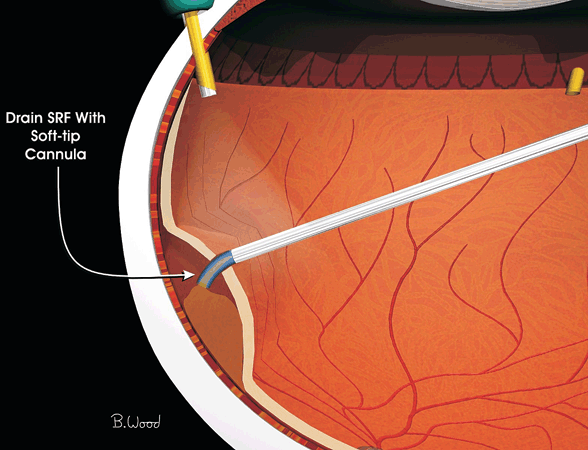
Figure 14.3  The soft-tip extrusion cannula can be used for drainage of SRF.
The soft-tip extrusion cannula can be used for drainage of SRF.
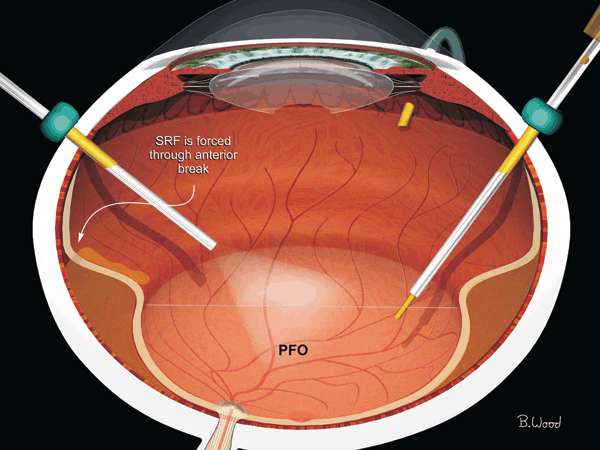
Figure 14.4  Liquid perfluorocarbon such as Alcon PFO displaces SRF anteriorly out through retinal breaks into the anterior vitreous cavity. PFO should be used if fluid-air exchange results in IOL fogging.
Liquid perfluorocarbon such as Alcon PFO displaces SRF anteriorly out through retinal breaks into the anterior vitreous cavity. PFO should be used if fluid-air exchange results in IOL fogging.
Complete removal of SRF can be accomplished by sequential drainage. After the initial drainage of SRF, there may be a thin layer of diffuse SRF that may be imperceptible. This SRF often recollects underneath the drainage retinotomy after approximately 30 seconds. At this time, redrainage can remove most of the remaining SRF (Fig. 14.5). This technique is best repeated until no SRF recollects. Laser treatment around the retinal tear or retinotomy can then be performed safely with sharp demarcation of laser uptake (Fig. 14.6).
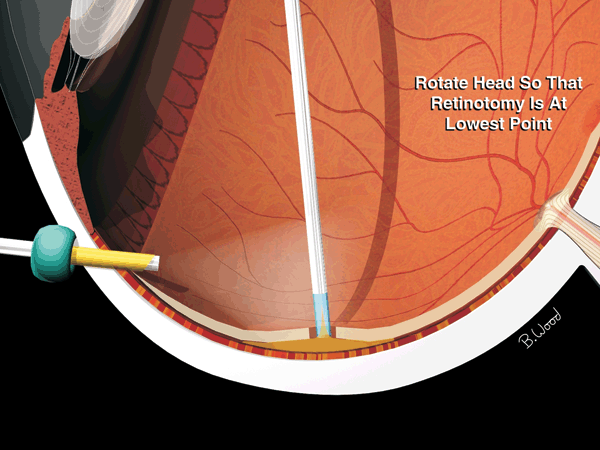
Figure 14.5  Redrainage facilitates complete removal of SRF.
Redrainage facilitates complete removal of SRF.
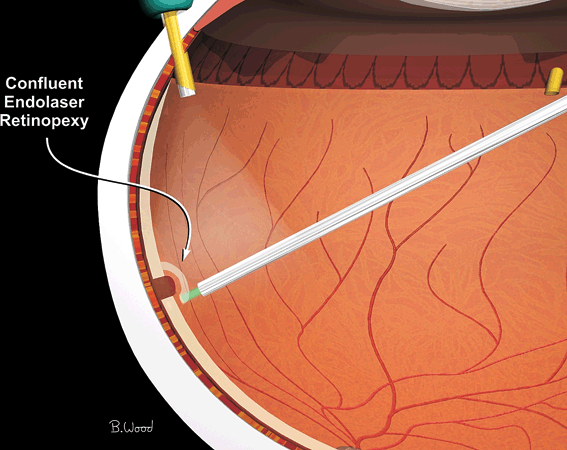
Figure 14.6  Complete removal of SRF improves the uptake of endolaser retinopexy around drainage retinotomy.
Complete removal of SRF improves the uptake of endolaser retinopexy around drainage retinotomy.
The authors use 25-gauge, sutureless, transconjunctival technique for all vitrectomy for retinal detachment. Advantages of 25-gauge technique over 20-gauge technique include (a) port-based flow limiting that produces greater fluidic stability and therefore less retinal motion, (b) less pain, (c) less inflammation, and (d) less conjunctival damage (important for patients with glaucoma filtering procedures and surface disorders). A 25-gauge, soft-tip cannula is used for simultaneous drainage of SRF and fluid-air exchange unless PFO is used. The 25-gauge, soft-tip cannula is excellent for air-gas exchange or PFO-gas exchange after endolaser to all retinal breaks.
Although many surgeons perform 360-degree laser in vitrectomy for retinal detachment and even macular hole cases, it is not known whether this reduces postoperative retinal detachment. Some surgeons use laser indirect ophthalmoscopy (LIO) instead of endolaser. The LIO approach could theoretically increase nuclear sclerosis as well as iris and corneal damage from laser energy absorption. It is possible that light scatter from the cornea and lens could cause macular damage as well. The only advantage to the LIO approach is less chance of bumping the lens during peripheral endolaser treatment. Lens bump can be eliminated by scleral depression and flexible or articulated laser probes as well as by using the laser probe in both the left and the right hand for better access.
It has not been shown that scleral buckling is needed when using vitrectomy for retinal detachment repair, and the authors believe that it is widely overutilized. The authors do not use scleral buckling in vitrectomy cases in order to reduce induced refractive error, strabismus, ptosis, pain, conjunctival swelling, and conjunctival damage.
SURFACE TENSION MANAGEMENT
All rhegmatogenous retinal detachments and traction retinal detachments with one or more retinal breaks require gas, medium-term PFO, or silicone oil surface tension management. Removal of the hyaluronan gel dramatically reduces the viscosity as aqueous humor fills the former vitreous cavity. This reduces the pressure gradient the retinal pigment epithelium pump can achieve across the retina. Subclinical retinal detachments rarely remain stable after vitrectomy; even very small holes usually result in a total retinal detachment in hours to days. Laser and cryo retinopexy sites reach maximum tensile strength at 10 to 14 days; SF6 bubbles often last 7 to 14 days, which means a full fill or isoexpansive SF6 is required to avoid the use of the longer duration C3F8.
MEDIUM-TERM PERFLUORON
The authors have been using medium-term PFO for inferior retinal detachments and giant breaks since 2002 in a prospective, consecutive series. The advantages are as follows: (a) the patients can be seated, reclining, or supine, not face down; (b) compared to scleral buckles, there is no induced refractive error, no strabismus, no ptosis, no pain, and no inflammation; and (c) the patients can fly on an airplane. Disadvantages are as follows: (a) two procedures are required, the second one to remove the PFO (this is often done with silicone oil as well) and (b) residual PFO droplets in the anterior chamber and former vitreous cavity. Droplets of PFO adhere to the zonules and pars plana and are common even after very compulsive surgical removal. Some investigators believe that PFO is toxic, but the authors have seen no evidence of toxicity and the patients have excellent visual function. Some patients develop mild inflammatory deposits on the retina and the lens, but these disappear in a few weeks after PFO removal. Intraocular pressure elevation has been seen by the authors in patients who have PFO migration into the anterior chamber. This technique, similar to using vitrectomy plus gas and laser, requires compulsive, 360-degree removal of vitreous traction with emphasis on traction to all retinal breaks (Fig. 14.7). Adequate peripheral vitrectomy requires wide-angle visualization and may require scleral depression. After vitrectomy, PFO is injected over the optic nerve with a MedOne double-bore cannula that enables infusion fluid to leak through the external lumen of the cannula to equilibrate the intraocular pressure (Fig. 14.8). Confluent laser is applied with the Alcon 25-gauge articulating laser probe to each retinal break and suspicious area. If SRF does not completely disappear, a very small drainage retinotomy can be made and SRF aspirated, being careful to not remove PFO. If vitreous traction is seen after PFO injection, it can be removed “under” PFO by carefully keeping the cutter port outside the bubble of PFO. This technique is called “interface” vitrectomy by the authors and is similar to vitrectomy “under” air or “under” silicone oil.
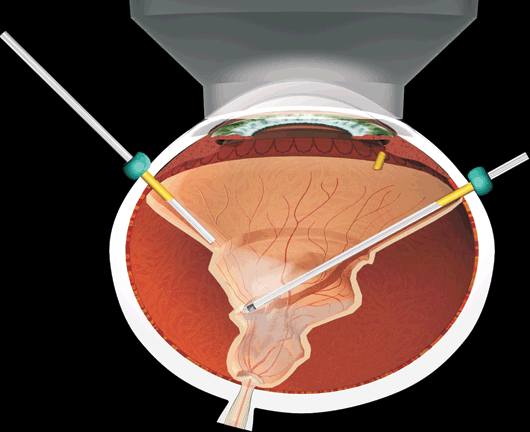
Figure 14.7  Medium-term PFO requires compulsive, 360-degree removal of vitreous traction using wide-angle visualization.
Medium-term PFO requires compulsive, 360-degree removal of vitreous traction using wide-angle visualization.
Stay updated, free articles. Join our Telegram channel

Full access? Get Clinical Tree


